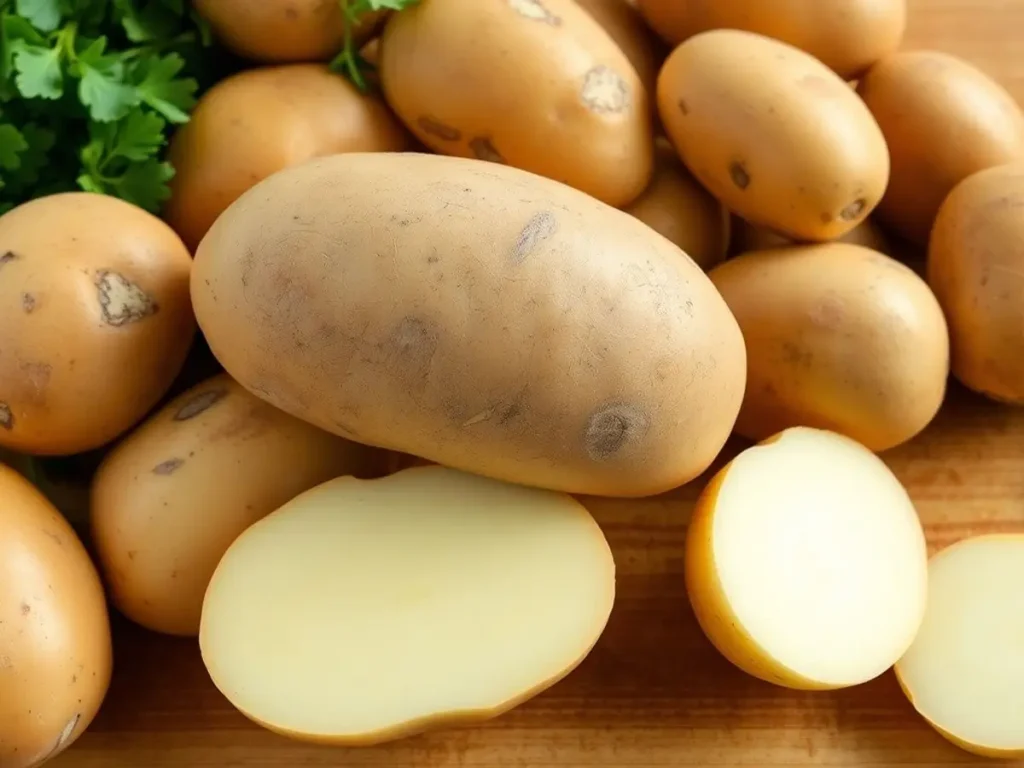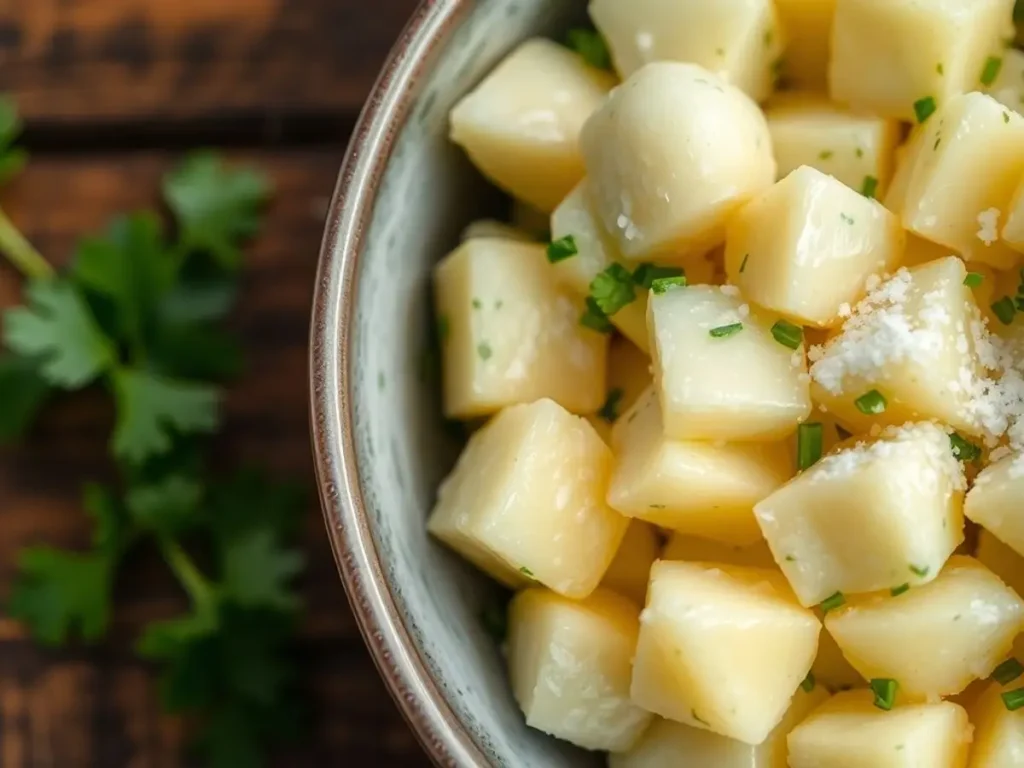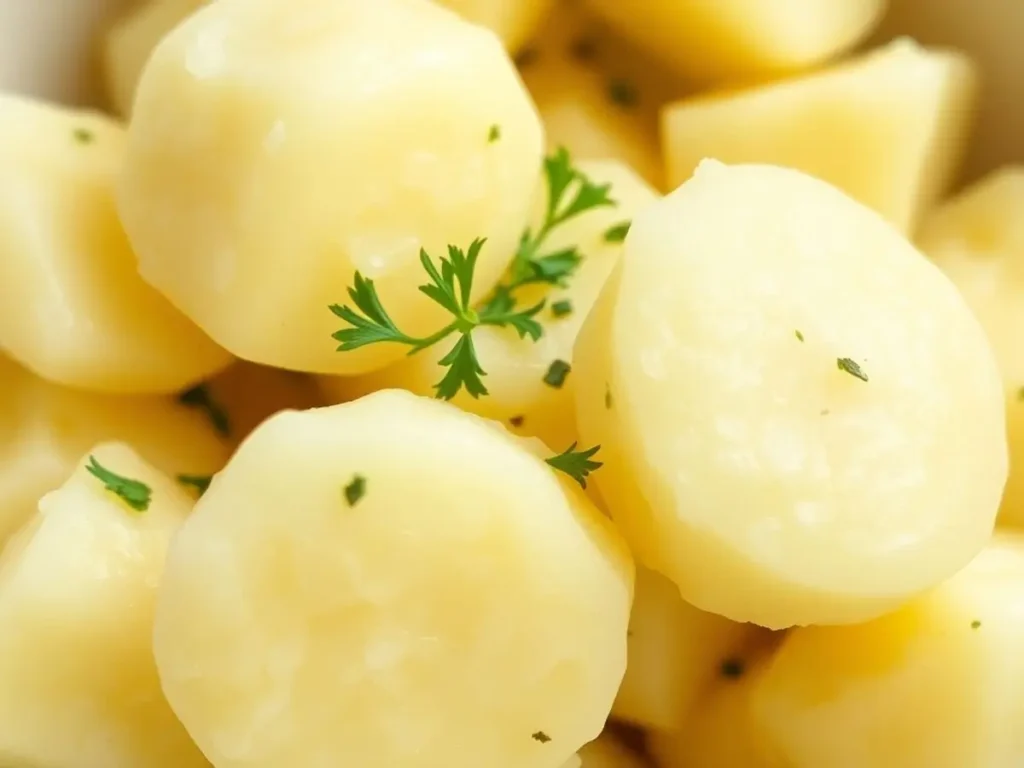Potato salad is that classic side dish that seems easy but can easily go wrong if you’re not careful. You might think it’s just about mixing potatoes with some dressing, but there’s more to it. Picking the wrong potato, skipping essential steps, or mistiming your dressing can turn your salad into a less-than-pleasant dish. Let’s break down what not to do when making potato salad to ensure your next batch is a hit.
Table of contents
Key Takeaways
- Choose waxy potatoes like red or fingerling for the best texture.
- Always salt your cooking water to flavor the potatoes from within.
- Avoid overcooking by testing potatoes with a fork for tenderness.
- Dress potatoes at the right temperature for the dressing type.
- Keep potato sizes consistent for even cooking.
Choosing the Wrong Potatoes

Understanding Potato Varieties
When it comes to making potato salad, not all potatoes are created equal. Picking the right type of potato can make or break your dish. Waxy potatoes like fingerling potatoes, red, and new varieties are ideal for salads because they hold their shape well after cooking. On the flip side, starchy potatoes like russets tend to fall apart, which might be great for mashed potatoes but not for a salad.
Why Waxy Potatoes Work Best
Waxy potatoes are your best friends in the quest for the perfect potato salad. They have a smooth texture and a thin skin, which means you can skip the peeling if you’re short on time. Plus, they absorb flavors well without becoming mushy. Here’s a quick rundown of why waxy potatoes are the go-to:
- Hold Shape: Maintains structure after boiling.
- Flavor Absorption: Soaks in dressings without disintegrating.
- Easy Prep: Minimal peeling required.
Avoiding Starchy Potatoes
Steer clear of starchy potatoes if you want neat, uniform pieces in your salad. These potatoes tend to break down during cooking, leading to a mushy texture that’s not ideal for a classic potato salad. If you accidentally grab a starchy potato, consider using them for another dish where a creamy texture is desired. Remember, the type of potato you choose directly impacts the final texture and taste of your salad.
If you’re looking for inspiration, the Ozette Potato Salad Recipe demonstrates how choosing the right potatoes can elevate your dish.
Choosing the right potato is like picking the right tool for a job — it makes all the difference in the outcome. Stick with waxy potatoes for a firm, flavorful salad every time.
Skipping the Salting Step

Importance of Salting Water
Potatoes are like sponges when it comes to flavor. If you skip salting the water when boiling them, you’re missing out on the chance to infuse the potatoes with taste right from the start. Just like with pasta, adding salt to the boiling water ensures that your potatoes are seasoned from the inside out. This step is crucial because once the potatoes are cooked, they won’t absorb salt as effectively, leaving you with bland bites.
How to Properly Salt Potatoes
Getting the salting right isn’t just about tossing a pinch into the pot. You need to be generous with the salt, as most of it will wash away when you drain the potatoes. Here’s a simple guide:
- Fill your pot with cold tap water and add your potatoes.
- Add a considerable amount of salt—think about a tablespoon per quart of water.
- Stir to dissolve the salt, then bring the water to a boil.
This method ensures the potatoes absorb the salt as they cook, giving them a well-rounded flavor.
Common Salting Mistakes
There are a few pitfalls to watch out for:
- Not adding enough salt: If the water tastes like the sea, you’re on the right track.
- Starting with hot water: Always begin with cold tap water to ensure even cooking.
- Skipping the salt entirely: This leaves you with potatoes that lack depth, no matter how much dressing you add later.
Remember, the goal is to build flavor at every step. Properly salted potatoes are the foundation of a delicious potato salad. Don’t underestimate this simple yet powerful step in your cooking process.
Overcooking or Undercooking Potatoes

Testing for Doneness
Getting the potatoes just right is like walking a tightrope. Too firm, and they’re crunchy; too soft, and they’re mushy. To test if your potatoes are done, poke them with a fork. If it slides in easily, they’re ready. Remember, the size of your potato pieces can affect cooking time. Smaller chunks cook faster, so keep an eye on them.
Timing Your Boil
Start your potatoes in cold water for even cooking. Bring them to a gentle boil and then reduce to a simmer. This method helps the potatoes cook evenly, avoiding the dreaded mushy outside and hard inside. Boiling potatoes too quickly can lead to uneven cooking, which nobody wants.
Adjusting for Potato Size
Not all potatoes are created equal. If you’re working with larger potatoes, cut them into smaller, uniform pieces to ensure they cook evenly. This way, you won’t end up with a mix of overcooked and undercooked bits.
Consistent sizing isn’t just about looks; it’s about ensuring every bite is perfectly cooked. So, get out that knife and make sure your pieces are even!
Here’s a quick checklist to keep in mind:
- Start with cold water.
- Simmer, don’t boil aggressively.
- Test with a fork for doneness.
- Adjust size for uniform cooking.
And don’t forget to reserve a cup cooking water before draining, just in case you need to adjust the consistency of your salad later.
Dressing Potatoes at the Wrong Time
Timing for Mayo-Based Dressings
When it comes to dressing your potato salad, timing is everything. Slathering mayo-based dressings on hot potatoes is a recipe for disaster. The heat causes the dressing to separate, leaving you with a greasy mess rather than a creamy delight. Instead, let the potatoes cool to room temperature before mixing in the mayonnaise. This way, the dressing clings perfectly to the potatoes without sliding off, ensuring every bite is as tasty as the last.
When to Use Vinaigrette
For those who prefer a lighter touch, vinaigrette is your friend. Unlike mayonnaise, vinaigrette benefits from being added while the potatoes are still warm. This allows the flavors to soak into the potatoes, creating a well-seasoned dish people will rave about. The oil and vinegar meld with the warm potatoes, enhancing their natural flavors without overpowering them. Just be sure to toss gently to avoid breaking the potatoes.
Impact of Dressing Temperature
The temperature of your dressing can dramatically affect the final product. A cold dressing may cause the potatoes to firm up, making them less absorbent. On the other hand, a warm dressing can lead to a more integrated flavor profile. Think about the history of warm potato salad, where the ingredients are mixed while still warm to create a cohesive and flavorful dish. Consider your desired outcome and adjust the dressing temperature accordingly to achieve the perfect balance.
Ignoring Potato Size Consistency
Why Size Matters
When making potato salad, the size of your potato pieces can make or break the dish. Inconsistent sizes lead to uneven cooking, which affects the overall texture. If some pieces are too large, they might remain undercooked, while smaller ones become mushy. This inconsistency can ruin the balance of flavors and textures you aim for in a perfect potato salad.
Tips for Even Sizing
- Use a sharp knife: A dull blade can lead to uneven cuts, so sharpen your knife before you start.
- Aim for uniformity: Try to cut your potatoes into pieces that are roughly the same size. This ensures they cook at the same rate.
- Consider the dish type: For a chunkier salad, larger pieces are fine, but if you prefer a smoother texture, go for smaller, evenly-sized cubes.
Avoiding Uneven Cooking
Uneven cooking is a common pitfall when potato sizes vary too much. To prevent this:
- Start with cold water: Place your evenly-cut potatoes in cold water before boiling. This helps them cook evenly from the outside in.
- Check doneness regularly: Use a fork to test the potatoes. They should be tender but not falling apart.
- Adjust cooking time: If you notice some pieces are cooking faster, reduce the heat and stir gently to distribute the heat evenly.
Getting the size right isn’t just about looks—it’s about ensuring every bite of your salad is just as delicious as the last. Consistent sizing helps bring out the best flavors and textures, making your potato salad a true crowd-pleaser.
Neglecting to Cool Potatoes Properly
Cooling Techniques
When making potato salad, cooling the potatoes properly is a step you shouldn’t skip. After boiling, drain the potatoes and spread them out on a baking sheet. This helps them cool evenly and quickly. If you’re in a rush, you can pop them in the fridge for a bit. Just make sure they’re not stacked, so they cool down evenly.
Why Cooling Matters
Cooling your potatoes is important because it helps them firm up a bit before you add any dressing. If they’re too hot, they might fall apart, and nobody wants mashed potatoes in their salad. Proper cooling keeps your salad from turning into a mushy mess. Plus, cooler potatoes will absorb the dressing better, giving you a more flavorful dish.
Avoiding Soggy Salad
Ever had a potato salad that was just too wet? That’s what happens when you don’t let your potatoes cool and dry enough. To avoid this, make sure there’s no excess water left after boiling. Let them sit for a few minutes to dry out before you start mixing. This way, your salad will have a nice texture, not a soggy one.
Letting your potatoes cool properly is a simple step that makes a big difference. It ensures your potato salad has the right texture and flavor, making it a dish everyone will enjoy.
Sticking to a Single Recipe
Exploring New Ingredients
When it comes to potato salad, sticking to the same old recipe can get a bit boring. Why not spice things up by exploring new ingredients? Adding a touch of creativity can transform your potato salad into a crowd-pleasing, shareable dish. Consider tossing in some peas or avocado for a fresh twist. These ingredients not only add a pop of color but also bring a delightful nutty flavor to the mix. If you’re feeling adventurous, try a Korean-style potato salad with carrots and cucumbers. It’s a delicious way to incorporate more veggies into your meal.
Elevate your dish with complementary sides like Sausage Muffins Made Easy for a crowd-pleasing combination.
Benefits of Recipe Variation
Switching up your potato salad recipe can open up a world of delicious dishes. Not only does it keep things interesting, but it also allows you to cater to different taste preferences. By varying your ingredients, you can create a combination of cooking water and flavors that suit any occasion. Whether it’s a picnic, barbecue, or family gathering, a unique potato salad can steal the show.
For a twist, try incorporating unique recipes like Sausage Muffins Without Bisquick into your spread.
Incorporating Seasonal Flavors
One of the best ways to keep your potato salad exciting is by incorporating seasonal flavors. As the seasons change, so do the ingredients available at your local market. Embrace this by adding fresh herbs, fruits, or vegetables that are in season. Not only does this enhance the flavor, but it also supports local farmers and adds a touch of freshness to your dish. Imagine a potato salad with the zest of summer tomatoes or the warmth of roasted autumn squash. The possibilities are endless, and your taste buds will thank you.
Pair your potato salad with perfectly cooked proteins such as Spatchcock Chicken to enhance any meal.
Experimenting with different ingredients and flavors can elevate your potato salad from ordinary to extraordinary. Don’t be afraid to step out of your comfort zone and try something new. After all, the best dishes often come from a little bit of experimentation and a lot of love.
Wrap-Up: Nailing That Potato Salad
So there you have it, folks! Making potato salad isn’t rocket science, but it does take a bit of know-how to avoid those common pitfalls. Remember, choosing the right type of potato is key—whether you like them waxy or starchy, just make sure they suit your style. And hey, don’t rush the process. Let those potatoes cool a bit before dressing them up, and always season your water. These little tweaks can make a world of difference. Next time you’re whipping up a batch, keep these tips in mind, and you’ll be the star of the picnic. Happy cooking!
Frequently Asked Questions
What type of potatoes should I use for potato salad?
Waxy potatoes like red, fingerling, or new potatoes are best because they hold their shape well during cooking.
Why is it important to salt the water when boiling potatoes?
Salting the water helps flavor the potatoes from the inside, making them taste better in the salad.
How can I tell if my potatoes are cooked properly?
You can test doneness by poking a fork into the potatoes. They should be tender but not mushy.
When should I add dressing to my potato salad?
For mayo-based dressings, let the potatoes cool first. For vinaigrettes, add while the potatoes are still warm.
What happens if I overcook my potatoes?
Overcooked potatoes can become mushy, but they can still be used if you prefer a creamier texture.
Can I change the ingredients in my potato salad recipe?
Yes, experimenting with different ingredients like herbs or veggies can add new flavors to your salad.
